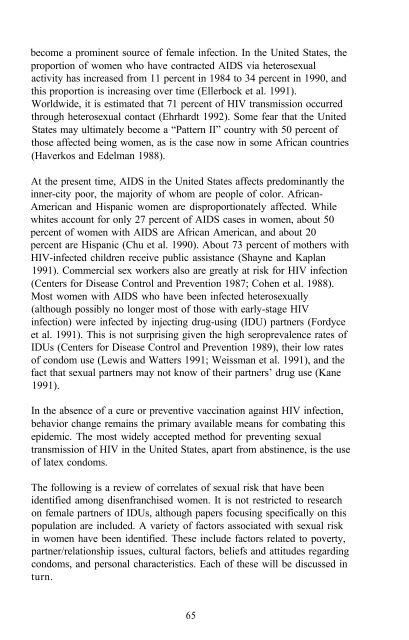The Context of HIV Risk Among Drug Users and Their Sexual Partners
The Context of HIV Risk Among Drug Users and Their Sexual Partners
The Context of HIV Risk Among Drug Users and Their Sexual Partners
You also want an ePaper? Increase the reach of your titles
YUMPU automatically turns print PDFs into web optimized ePapers that Google loves.
ecome a prominent source <strong>of</strong> female infection. In the United States, the<br />
proportion <strong>of</strong> women who have contracted AIDS via heterosexual<br />
activity has increased from 11 percent in 1984 to 34 percent in 1990, <strong>and</strong><br />
this proportion is increasing over time (Ellerbock et al. 1991).<br />
Worldwide, it is estimated that 71 percent <strong>of</strong> <strong>HIV</strong> transmission occurred<br />
through heterosexual contact (Ehrhardt 1992). Some fear that the United<br />
States may ultimately become a “Pattern II” country with 50 percent <strong>of</strong><br />
those affected being women, as is the case now in some African countries<br />
(Haverkos <strong>and</strong> Edelman 1988).<br />
At the present time, AIDS in the United States affects predominantly the<br />
inner-city poor, the majority <strong>of</strong> whom are people <strong>of</strong> color. African-<br />
American <strong>and</strong> Hispanic women are disproportionately affected. While<br />
whites account for only 27 percent <strong>of</strong> AIDS cases in women, about 50<br />
percent <strong>of</strong> women with AIDS are African American, <strong>and</strong> about 20<br />
percent are Hispanic (Chu et al. 1990). About 73 percent <strong>of</strong> mothers with<br />
<strong>HIV</strong>-infected children receive public assistance (Shayne <strong>and</strong> Kaplan<br />
1991). Commercial sex workers also are greatly at risk for <strong>HIV</strong> infection<br />
(Centers for Disease Control <strong>and</strong> Prevention 1987; Cohen et al. 1988).<br />
Most women with AIDS who have been infected heterosexually<br />
(although possibly no longer most <strong>of</strong> those with early-stage <strong>HIV</strong><br />
infection) were infected by injecting drug-using (IDU) partners (Fordyce<br />
et al. 1991). This is not surprising given the high seroprevalence rates <strong>of</strong><br />
IDUs (Centers for Disease Control <strong>and</strong> Prevention 1989), their low rates<br />
<strong>of</strong> condom use (Lewis <strong>and</strong> Watters 1991; Weissman et al. 1991), <strong>and</strong> the<br />
fact that sexual partners may not know <strong>of</strong> their partners’ drug use (Kane<br />
1991).<br />
In the absence <strong>of</strong> a cure or preventive vaccination against <strong>HIV</strong> infection,<br />
behavior change remains the primary available means for combating this<br />
epidemic. <strong>The</strong> most widely accepted method for preventing sexual<br />
transmission <strong>of</strong> <strong>HIV</strong> in the United States, apart from abstinence, is the use<br />
<strong>of</strong> latex condoms.<br />
<strong>The</strong> following is a review <strong>of</strong> correlates <strong>of</strong> sexual risk that have been<br />
identified among disenfranchised women. It is not restricted to research<br />
on female partners <strong>of</strong> IDUs, although papers focusing specifically on this<br />
population are included. A variety <strong>of</strong> factors associated with sexual risk<br />
in women have been identified. <strong>The</strong>se include factors related to poverty,<br />
partner/relationship issues, cultural factors, beliefs <strong>and</strong> attitudes regarding<br />
condoms, <strong>and</strong> personal characteristics. Each <strong>of</strong> these will be discussed in<br />
turn.<br />
65
















